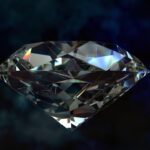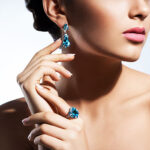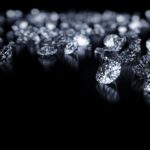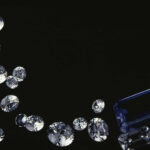Diamond Buying Tips
- Home
- Diamond Buying Tips
Diamond Guide – Diamond Buying Tips
A diamond is purely made of carbon, which is one of the Earth’s most common elements. The diamond is the hardest known substance in the world and is uniquely resistant to damage by heat or scratching, and can be cut or polished only by another diamond.
Whether you buy diamonds or diamond jewelry for yourself or for your loved ones often your decision to buy a diamond is based on some emotion. Buying a diamond or diamond jewelry is an expensive purchase and it is advisable that you acquire some knowledge about diamonds and their characteristics. You can get detailed information on each and every aspect of diamond knowledge in our diamond guide.
Diamond Buying Tips :
The diamond buying tips mentioned below will help you find the diamond you are looking for.
- When you buy a sparkling diamond, you must consider the 4Cs of diamonds – Cut, Color, Clarity, and Carat weight, as a basis for your decision. The 4Cs will help you to choose the best diamonds on the same criteria that jewelers use to select them.
Diamond Cut
- A diamond’s cut is the most important attribute for enhancing a diamond’s beauty because a well cut diamond reflects light to maximize the stone’s brilliance.
- When we talk about diamond cut by depth, the ideal cut is considered the best cut, as it reflects most or all of the light that enters the diamond back to the eyes. Diamond cut by shape describes the outline of the stone and pattern of the facet arrangement. You can find a diamond in various shapes like Round, Princess, Heart, Oval, Pear etc. Polish and symmetry are also important for a well cut diamond. The diamond polish displays the smoothness of the diamond’s facets, whereas the symmetry refers to alignment of the facets.
Buying Tips for Diamond Cut
- You should always look for the ideal cut diamond with the desired shape. You should also ensure that the diamond is properly polished and has perfect symmetry.
- Diamond shape is a matter of personal choice. A brilliant round shaped diamond is one of the most desirable shapes and offers maximum brilliance.
Diamond Color
- Diamond color is also a vital factor to look for as diamonds are found in almost all the colors. Most diamonds appear white to the naked eye, but they all include trace amounts of yellow or brown color. Slight difference in diamond color can make a substantial difference in value. A truly colorless diamond is extremely rare and considered the most valuable. It allows the most light to pass through the stone and create the most brilliance.
- The diamond color scale goes from D to Z, with D being the most white and Z being the most yellow.
- Diamonds are also found in various intense colors like pink, greens, brown, red, orange, blue etc. These intensely colored diamonds, known as fancy colored, are very rare, attractive and desirable. A deeply colored diamond can cost more than its colorless counterpart. In fancy colored diamonds, the Z+ grade is used for color grading.
- Fluorescence, to some extent, is common in the majority of diamonds but it remains unnoticed by human eyes in ordinary light. Fluorescence is a form of illumination that is created when a diamond is exposed to low or high wave ultraviolet radiation.
Buying Tips for Diamond Color
- The best way to see the true color of a diamond is by looking at it against a white surface. Even though stones in the D-F color grades are the most valuable, you can still find great value and save substantial money with diamonds in grades G-J and K-M, since no color is visible to the untrained eye.
- Even stones in the N-R range have a very light hint of yellow, which may be invisible to the untrained eye, and can appear colorless in the right jewelry setting.
- Usually yellow metal (gold) hides traces of color in a colorless diamond, while white metal (white gold, platinum, silver) enhances it. While buying a fancy colored diamond, you should look at basic hue and intensity of color.
- Faint or medium fluorescence will rarely affect a diamond’s appearance.
Diamond Clarity
- Clarity is a term used to describe the absence or presence of flaws inside or on the surface of a diamond.
- When flaws occur internally, they are called inclusions. The most common types of inclusions include crystals, needles, knots, chips, cavities, cleavage, feathers etc. When these flaws occur on the surface, they are known as blemishes. The most common types of blemishes include polish lines, naturals, scratches, nicks, pits, extra facets, etc.
- A diamond’s clarity is based on the number, size, nature and location of imperfections on the finished stone. Clarity of a diamond affects the beauty and value of the diamond.
- A diamond with higher clarity is more valuable in comparison to a diamond that contains numerous inclusions because it is less brilliant, as the inclusions interfere with light passing through it.
Buying Tips for Diamond Clarity
- Your budget will generally dictate the size/carat weight of the diamond you can buy.
- You should consider buying an average sized diamond with good cut, color and clarity rather than buying a larger diamond with a lesser quality cut, color and clarity.
- The term ‘Carat’ is different from the term ‘Karat’ which is used to describe gold’s fineness or purity.
Diamond Carat Weight
- The term “Carat” refers to the weight of a diamond. 1 carat equals 0.2 grams or 1/142 of an ounce.
- A carat may also be measured in points, and 1 carat is 100 points. Therefore, ¼ carat diamond is 25 points and ½ carat diamond is 50 points and so on.
- The price of a diamond rises exponentially with its size. So, a 2 carat diamond of a given quality is always worth much more than two 1 carat diamonds of equal quality.
Buying Tips for Diamond Carat Weight
- Your budget will generally dictate the size/carat weight of the diamond you can buy.
- You should consider buying an average sized diamond with good cut, color and clarity rather than buying a larger diamond with a lesser quality cut, color and clarity.
- The term ‘Carat’ is different from the term ‘Karat’ which is used to describe gold’s fineness or purity.
Diamond Certificate
- A Diamond Certificate or Diamond Grading Report is a statement issued by an independent Gemological Laboratory, At the time of evaluation, the diamond in question has been examined, measured, and scrutinized by experienced diamond graders, using various gemological instruments, and determined to contain the characteristics as stated in the Certificate or Report.
- There are many reputed laboratories available for diamond certification, which are known for their consistency and unbiased diamond grading system, for example, the Gemological Institute of America (GIA) and the American Gem Society Laboratories (AGSL).
Buying Tips for Diamond Certificate
- When you buy a diamond, you should always ask for a diamond certificate. It may cost you a little more money but it will provide you much-needed peace of mind knowing that you are getting your money’s worth.
- A diamond certificate gives you the exact details/physical properties of the stone. Based on this information you will be able to do some comparison-shopping before doing the actual purchase.
- A diamond certificate allows you to buy based on a stone’s measurable characteristics.
- If you re-sell your diamond along with its certificate, you will get a better price for the diamond.
- To get insurance for your diamond, you also need to produce a diamond certificate.
General Buying Tips
- You should set your budget for buying a diamond and then explore your options. This way, you’ll find a wide range of diamonds with different carat weights and qualities in your price range.
- Buy a diamond using the basic criteria of the 4Cs and suitable to your budget.
- You should give priority to diamond cut, color and carat weight over diamond clarity. Imperfections may be so small that they have no measurable effect on the diamond’s brilliance. Brilliance is almost entirely the result of the cut and proportions of the diamond.
- When you are buying a diamond for your loved one, always keep his/her personality and preferences in mind.
- You should ask your jeweler to give you information about the origin of the diamonds he is selling, so you don’t end up buying a conflict diamond.
- You should also ask your jeweler if the diamond you are considering buying is treated to enhance color or cover flaws. A treated diamond should cost less than a natural diamond.
- Always buy a diamond from a reputed and known jeweler. If you don’t know any good jewelers, then you should ask your family members or friends for their recommendations or do your research.
- Beware of jewelry store lighting which may be quartz or halogen bulbs. These can be deceiving as they blast high-intensity streams of light into goods to enhance their looks.
- When buying a diamond, you should not be in a hurry or under pressure. You should buy it at your convenience and at your own pace.
These tips should enable you to buy a diamond with more confidence and always remember that ‘Diamonds are forever’. They won’t depreciate or wear out like a car or a computer in few years. So enjoy buying the world’s most exceptional item by keeping the above mentioned buying tips in mind.Find Ways to Save.
No two diamonds are the same; prices differ based on cut, carat, clarity, and color. To get the most bling for your buck, consider these tips:
- Choose a 0.9-carat stone rather than one carat (or 1.9 carats instead of two). The difference is nearly imperceptible but could save you as much as 20 percent.
- Compromise on color and clarity. If you’re willing to compromise on color and clarity, you can get a larger stone. “My clients come in wanting an F color with very slight inclusions, but soon realize they can lower the quality to get a larger size or spend less money at the same carat weight,” Gottlieb says.
- Pick a lower-clarity stone with a brilliant cut. Its many facets will hide imperfections, Lawler-Trustey says. If you’re after a step-cut stone (Emerald or Asscher), choose clarity over color: These styles are cut to have wide, flat “tables” so even the smallest imperfection can be completely visible to the naked eye.







